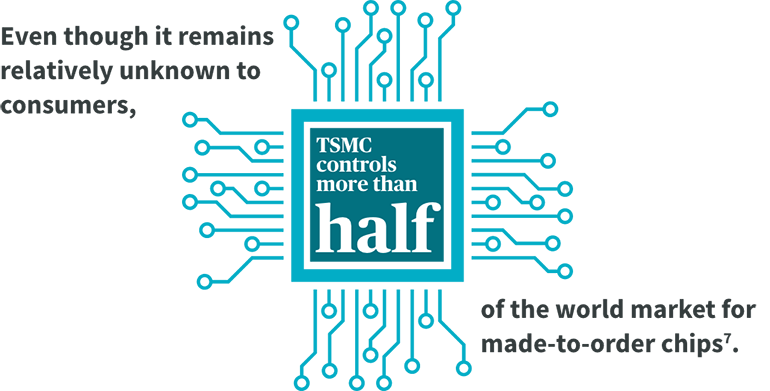
The expanding middle class: why global affluence is a developing trend
- 17 Agosto 2021 (10 min de lectura)
Despite Covid-19 sending 100 million back into poverty, society is getting wealthier over the long term
Over the past few decades, a quiet revolution in living standards has been transforming the world’s population, reducing extreme poverty and leading to the emergence of the global middle class.
By 2018, just over half the world’s population were living in households with enough discretionary expenditure to be considered middle class or rich — an unprecedented milestone, according to the Brookings Institute.
“For the first time since agriculture-based civilisation began 10,000 years ago, the majority of humankind is no longer poor or vulnerable to falling into poverty,” the US-based think tank concluded. “2018 marks a global tipping point.”
Three years on, that fundamental change has huge implications for investors as global consumption, particularly in developing economies, shifts from fulfilling basic needs to satisfying more aspirational desires.
For equity investors, taking advantage of this long-term trend in the evolving economy means looking beyond traditional geographies or sectors to consider a wide range of companies involved in everything from access to medicines to infrastructure projects that connect people and societies.
Covid-19: A permanent reversal of emerging market developments?
One question hanging over all of this is the effect of Covid-19, which has impacted populations around the world but has hit developing and poorer nations particularly hard.

Yet now, as vaccines are rolled out, there is renewed hope that the longer-term shift in transforming societies will resume apace thanks to powerful structural factors that have been at work for more than a decade.
The first of these is youth. In 2015, Africa had 226m people aged between 15 and 24, representing almost 20 per cent of the continent’s population2 . Yet that figure is expected to rise to 42 per cent of the population by 2030 — and to continue growing throughout the rest of the century.

Banking on the middle class
A second structural engine driving the global middle class is formalisation, for example through the growth of regional banking sectors. Asia has experienced such a rapid increase in the number of bank accounts and assets in the banking system in recent years that the region’s banks today account for about 50 per cent of the market capitalisation of the top 100 banks globally4 .
“It wasn’t so long ago that banks in Asia looked to the West as they developed products, services and business models,” the consultancy McKinsey observed last year5 . “The relationship between East and West is changing rapidly.”
Amanda O’Toole, Portfolio Manager of AXA Investment Managers’ (AXA IM) Global Thematics and Clean Economy strategies, argues that these longer-term factors are likely to drive a deepening of the global middle class for years to come.
“From a humanitarian perspective, many developing countries have felt the full impact of the pandemic,” she says. “But longer term, the wealth shift continues.”
Shifting with the times
From an investor perspective, many of the world’s big brands are well placed to continue taking advantage of that shift. Nike, the sportswear and equipment brand, reported a big jump in its third-quarter revenue, as sales in Greater China grew 42 per cent in the three months to the end of February — even when stripping out the effect of exchange-rate movements6 *.
But the opportunities extend far beyond the better-known names into much younger companies involved in everything from urbanisation-related infrastructure to the expansion of digital services, networks and devices.
TSMC, the Taiwanese semiconductor company founded in 1987, has grown into a global powerhouse in recent years.

This year the company, which continues to focus production in Taiwan, confirmed plans to invest $100bn over the next three years to expand capacity and help fill the global semiconductor shortage.
HDFC, an Indian bank founded in 1994, is now the country’s largest private-sector bank by assets and has grown at rates close to — or in excess of — 20 per cent a year for years8 . The bank started out by lending exclusively to big companies with investment-grade ratings. But it quickly moved into the retail space, rolling out products that are helping to serve the country's developing middle class. Today, HDFC Bank has a network of 5,608 branches and 16,087 ATMs in 2,902 cities and towns9 .
Some of the companies exposed to rapidly growing developing economies are founded and listed in the UK. Helios Towers, a company specialising in infrastructure for mobile networks, and which has huge presence in the fast-emerging African market, was established as recently as 2009. Yet revenue grew 7 per cent last year to hit $414m10 .
AXA IM’s O’Toole says that the pandemic, and the way it has affected some developing countries more than others, underscores the need to focus both at the company level and country level. 'It's important to use a fundamental analysis to establish which companies will be the winners from these changes, as not every stock will benefit from the rising middle class,' she says.
Yet with structural factors continuing to expand the global middle class over the long term, investors are likely to have compelling opportunities among companies serving these transitioning societies for many years to come.
Investment involves risks, including the loss of capital.
- WzJdIFBvcHVsYXRpb24gRmFjdHM6IFlvdXRoIHBvcHVsYXRpb24gdHJlbmRzIGFuZCBzdXN0YWluYWJsZSBkZXZlbG9wbWVudCIgKFBERikuIFVOIERlcGFydG1lbnQgb2YgRWNvbm9taWMgYW5kIFNvY2lhbCBBZmZhaXJzLCBQb3B1bGF0aW9uIERpdmlzaW9uLCBhcyBvZiBNYXkgMjAxNQ==
- SG93IEFzaWEgaXMgcmVpbnZlbnRpbmcgYmFua2luZyBmb3IgdGhlIGRpZ2l0YWwgYWdlLCBNY0tpbnNleSwgRmVicnVhcnkgMjAyMA==
- SG93IEFzaWEgaXMgcmVpbnZlbnRpbmcgYmFua2luZyBmb3IgdGhlIGRpZ2l0YWwgYWdlLCBNY0tpbnNleSwgRmVicnVhcnkgMjAyMCA=
- TklLRSwgSW5jLiBSZXBvcnRzIEZpc2NhbCAyMDIxIFRoaXJkIFF1YXJ0ZXIgUmVzdWx0cywgTklLRSwgYXMgb2YgMTggTWFyY2ggMjAyMQ==
- IEhERkPigJlzIFB1cmk6IEluZGlh4oCZcyBiaWcgcGljdHVyZSBiYW5rZXIsIEV1cm9tb25leSwgU2VwdGVtYmVyIDIwMjA=
- QWJvdXQgSERGQyBCYW5rLCBIREZDIEJhbmssIGFzIG9mIDIwIEFwcmlsIDIwMjE=
- SGVsaW9zIFRvd2VycyBwbGMgYW5ub3VuY2VzIHJlc3VsdHMgZm9yIHRoZSB5ZWFyIGVuZGVkIDMxIERlY2VtYmVyIDIwMjAsIEhlbGlvcyBUb3dlcnMgcGxjLCBhcyBvZiAxMCBNYXJjaCAyMDIx
Advertencia sobre riesgos
El valor de las inversiones y las rentas derivadas de ellas pueden disminuir o aumentar y es posible que los inversores no recuperen la cantidad invertida originalmente.